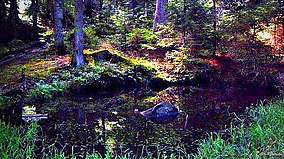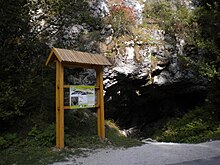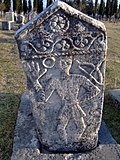| This article needs additional citations for verification. Please help improve this article by adding citations to reliable sources. Unsourced material may be challenged and removed. Find sources: "Bijambare Nature Park" – news · newspapers · books · scholar · JSTOR (February 2022) (Learn how and when to remove this message) |
| Bijambare Nature Park | |
|---|---|
| IUCN category V (protected landscape/seascape) | |
 Bijambare forest Bijambare forest | |
 | |
| Location | Bosnia and Herzegovina |
| Nearest town | Olovo, near village Krivajevići (Ilijaš) |
| Coordinates | 44°5′21″N 18°30′17″E / 44.08917°N 18.50472°E / 44.08917; 18.50472 |
| Area | 4.97 km (1.92 sq mi) |
| Elevation | 950 m (3,120 ft) |
| Established | 2003 |
The Bijambare (Serbian Cyrillic: Бијамбаре) area, well-known for its cave complex, is located on the far north-eastern slopes of Ilijaš municipality, near Olovo a small town near Sarajevo, capital of Bosnia and Herzegovina. The protected landscape area is within boundaries of the Nišići plateau. It is accessible by the main road Sarajevo-Olovo, from which an asphalt road branches out leading towards a mountain home and the especially known Bijambare cave. Large parts of these caves are open to visitors.
Protected landscape

The middle part of Bijambare is a karst plateau with all its commonly observed characteristics: caves, lost rivers, intriguing funnel-shaped depressions, rocky massifs and Bijambarsko Lake. There are numerous karst caves in the protected area, explored so far are the Middle (The Main) Bijambare Cave, Ledenjača, Lower Bijambare Cave, Ðuričina Cave, Upper Bijambare Cave, Dimšina Cave, Ledenica and New Cave. The largest and most famous of the caves is the Bijambare Cave, which is open to visitors. It is 420 meters long and is criss-crossed by four corridors that are up to thirty meters high and sixty meters wide. The largest corridor is also called the “concert hall” due to its size around 60 m in diameter and 15–30 m in height. The cave has numerous stalactites, stalagmites and curtains as well as tuff stones. It is also called the "music hall" for its acoustic effects.
Biodiversity

It is home to numerous species of mushrooms and medicinal plants.
Tourist attraction

The Bijambare cave has been a popular tourist spot and a speleological site for a long time. Area optimum height above sea level (950 m on average), thick conifer woods, meadows, two water flows with lakes and chasms, five caves, rocky massif and high quality air provide ideal conditions for alpinism, speleology, skiing, mushroom picking, medicinal herb picking, or simply for nature excursions and visits.
See also
References
- Bijambare Wikimapia
- Bijambare Protected Planet
- Bijambarsko jezero Mapio.net
- J. Mulaomerović, S. Milanolo "Protected landscape Bijambare" - speleology component Naše Šume 2011 Vol.10 No.24/25 pp.36-46 ISSN 1840-1678
- Bijambare Tour
| Caves of Bosnia and Herzegovina | ||
|---|---|---|
| List of caves in Bosnia and Herzegovina | ||
| Unexplored, flooded |  | |
| Caves with paintings, pictograms & cave prehistoric sites | ||
| Subterranean river | ||
| Caves with underground lakes | ||
| Caves with wellsprings | ||
| Estavelle caves (Ponor) | ||
| Show caves & explored | ||
| Most Bosnia and Herzegovina caves belong to Dinaric Alps and are kast caves | ||
| Cave topics | |
|---|---|
| Glossary of caving and speleology | |
| Main topics | |
| Types and formation processes | |
| Speleothems and Speleogens (Cave formations) | |
| Dwellings | |
| Popular culture | |
| Incidents | |
| Protected areas of Bosnia and Herzegovina | |
|---|---|
| National parks (IUCN Category II) | |
| Nature parks (IUCN Category III) | |
| Protected landscapes (IUCN Category V) | |
| Areas proposed for protection |
|
